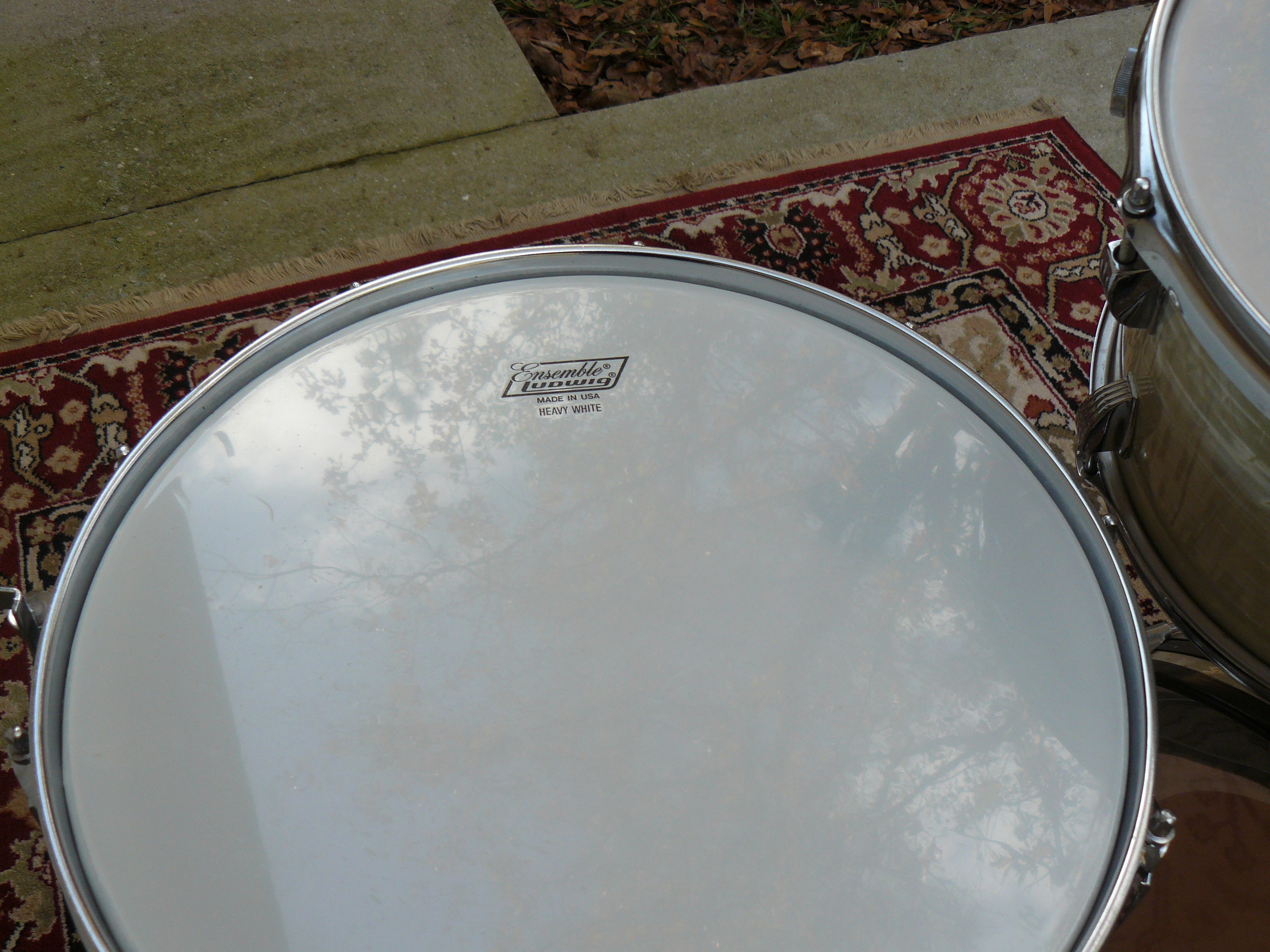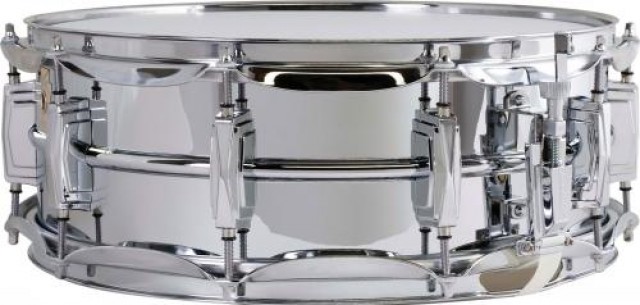My project started with a bunch of Ludwig drums and assorted cymbals I bought from a guy going the digital route. Beneath the grime and stickers were a partial club date kit, 14" and 16" WMP B/O toms, and a super sensitive snare.
Read more1970s Ludwig Green Vistalite Big Beat outfit
I don't understand why green was not a very popular color among the Vistalites produced by Ludwig in the 1970s. Some collectors claim, that Mr. Bill Ludwig said, there were only about fifty green sets made in the 1970s. I have my doubts about that number, but we know there are a lot fewer green sets than clear or blue. The darker green and red sets just didn't sell as well as the clear and lighter colors. The amber color got a big boost from John Bonham's using them on tour with Led Zeppelin.
Read more1935-1936 Ludwig Silver Anniversary 5x14 Engraved Black Beauty, Super Ludwig model
In 1935, Ludwig & Ludwig Drum Company celebrated its 25th “Silver” Anniversary and issued a series of redesigned Silver Anniversary snare drums in Standard, Super-Ludwig, and Super-Sensitive models. Mark Cooper (Cooper’s Vintage Drums) has noted that while the Silver Anniversary occurred in 1935, these drums did not appear in print until 1936 (Ludwig Drummer Magazine, Ludwig Silver Anniversary Edition catalog 36-A).
Read more1967 Ludwig Super Classic bought right off the Ludwig factory Showroom
I had mentioned above that this was a floor model at the Ludwig factory. I found this to be quite interesting to be able to buy back then as such. But when I took the kit apart to smell the interiors (wink ;-) and check the date stamps, I discovered the initials BL in the drums. I could not help myself, so I reached out to Bill Ludwig III and explained what I had and the story.
Read more1936 Ludwig & Ludwig 6.5 x 14 WMP/Chrome Silver Anniversary Super Sensitive Model
I rarely sell or trade my snare drums but this was an easy deal. The drum that I traded to Mark was a 1920s-30s Gretsch Emerald Green Pearl American Model. Mark is Mr. Sea Green Pearl and has the matching Gretsch EGP bass drum so I was happy to be able to help him get the matching snare drum and in turn Mark added another rare snare drum to my collection.
Read more1965 Ludwig "Superbeat" in oyster blue pearl
This is one of those kits that you dream of finding and it actually found me. I run an ad on the local Craig’s List looking for vintage drums. One day I get an email from an older gentleman telling me about this kit he may want to sell......
Read more1929-30 Ludwig Ralph Smith Drum Outfit
In my relentless pursuit of vintage drums, I came across an interesting Ebay listing: “Early 1900's Vintage Ludwig Drums, Black Beauty Snare, Zildjian, Zenjian Cymbals”. While the pictures weren’t very sharp, I could definitely see a 1920s-1930s engraved Ludwig Black Beauty in what appeared to be the original case. There were four cymbals, a bass drum and clearly a bunch of assorted hardware, all in De Luxe finish. Normally, I just collect snare drums but in this instance, I decided to make an exception. So I pulled the trigger.
Read more1970s Ludwig white marine pearl Big Beat kit
"Let it snow, let it snow, let it snow." I really don't wish for snow in the south. We are really not equipped too handle snow. A small snow storm will shut us right down in Georgia. I do like "the white stuff", though. Not the snow but white drums.
Read moreLudwig LM400 Supraphonic
Model: Ludwig LM400 Supraphonic 5x14 snare drumYear: 1963 to present
Description: Current model is U.S. made and has a spun aluminum seamless shell with chrome plating, imperial lugs, and a P85 throw off.
Prices as of 12/01/2013: Current Retail Price: NEW $695 (MAP $459) Excellent Condition Used (High Price): $300 Good Condition Used (Median Price): $200 Fair Condition Used (Low Price): $100
Opinions and debate about these average values are welcome in the comments section below, and values will change according to review of evidence present. Also welcome are comments about identifying features and timeline.
History and Identification :
The Ludwig Supra Phonic snare drum is one of the most popular snare drums of all time. It was used extensively on records by rock and jazz drummers of the fifties, sixties and seventies. Who knows how many hundreds of thousands of them were made over six decades? The SupraPhonic was introduced as the Super Ludwig in 1958 and was available in 5" depth only. The "Supra", as it was nicknamed, went through many major and minor changes over the years. The early chrome over brass shells and brass hoops are more desirable and rarer than the later chrome over aluminum shell drums and steel hoops. The chromed brass and chromed aluminum shells are hard to distinguish between and lots of fuss is made by collectors over how to tell the difference. The timeline of the changes below will help you date your drum. The only true 100% guaranteed way to tell if it's a brass shell underneath the chrome is to take one of the lugs or the strainer off the drum and remove a tiny bit of the chrome from the lug hole with a small file. If the brass shows through - bingo! If it's a darker grey color it's aluminum. Also if the chrome is flaking off the drum, it's an aluminum shell. Aluminum does not like to be chromed. Why are the brass ones so desirable? -The rarity and the superior tone.
The 1958 - 1963 chrome over brass and clear lacquer over brass shell Super Ludwigs range in price from $600 to $1000. Most aluminum and steel models correspond to the pricing above. A new or used Supraphonic of any stripe is a drum worth owning.
Super Ludwig and Supraphonic Timeline
1958: WFL badge (very rare), WFL P83 throw off, narrow crimped snare beds, brass shell has two folds- one flange downward from the bearing edge and a second fold back toward the shell, different from the aluminum shell which does not have the second fold. These drums are the best sounding of all the Supras because of the extra flange in the edge.
1958 - 1959: Ludwig Keystone brass and blue "transition" badge
1958 - 1960: Two piece brass shell w vertical weld seam, crimped narrow snare beds
1960 - 1963: Brass keystone badge w no serial number & etched characters. 6.5" depth model LM402 added, imperial lugs redesigned to be more hollow thus lighter
1961: Lacquered brass shell discontinued, a few shells were made out of steel, the one piece spun aluminum shell with one flange is introduced. The aluminum shells are lighter in weight and higher in pitch than the brass shells. Super Sensitive Supraphonic is introduced, snare beds widened to 8", round knob muffler replaced by the P-4067 "baseball bat" muffler w red felt. The felt was changed to white in 1964
1963: Name changed from Super Ludwig 400 to Supra-Phonic 400, serial numbers began to be stamped on badges in late 1963 - 4 digits - in '64 five digits - and in '65 six digits, Lug screws changed from hex head screws and washers to flat head screws w small bell washers.
1964: Brass hoops were changed to steel, felt on baseball bat muffler changed to white felt
1968: Baseball bat muffler replaced by 1" knob muffler, P83 strainer replaced with P85, shell material changed to a different non ferrous aluminum alloy; these shells are stamped AG on the inside
1969: First Blue and Olive parallelogram badges w no serial numbers, a few Supras were made without badges during this transition
1970: Lud-a-loy stickers added to inside of shell, a few Supraphonic 400 snares are made with brass shells and can be identified by the letters B or BR stamped by the muffler, and by modified shorter blue and olive badges.
1977: Strainer and butt height changed from 1/2" to 7/8"
1980: P85 12 strainer holes for gut snares changed to just two holes for wire snare strings
1984: P85 two hole model replaced by one slot P85 model
1988: Monroe badge replaces old Keystone badge
1994: New options offered on a Supraphonic 400: tube lugs, hammered shells, brass shells and bronze shells
There are exceptions to all of these variations and changes. Ludwig experimented a lot with different components, especially during the early sixties. One can find drums with the wrong shell, badges, lugs, and other parts that were factory originals due to shortages, old stock, custom builds for artists, etc., so these identifying factors are not written in stone, but it is a fairly reliable guide.
I am not the world’s foremost authority on vintage drums but I know enough to get me in trouble and I know there are guys and gals who know more than I do! Please, if you have differing information and opinions, I would love to hear from you in the comments below, but please be civil about it.
Thanks, George Lawrence - who wishes now that he hadn't sold his 1963 COB Supra.








































